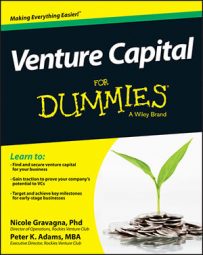Venture capitalists are highly visible because they work with high-profile companies. Because of this visibility, most people know that they exist and that they help companies grow. Many people also think that the key to growing any business successfully is to involve venture capitalists.
It turns out, however, that only a small subset of all companies can benefit from using venture capital to grow. The reason is two-fold: Venture capitalists are extremely selective about the types of companies that they are willing to invest in; and many businesses would do better (for a variety of reasons) by choosing a different method of growth.
In addition, entrepreneurs sometimes make a conscious choice to avoid taking venture capital, even if VCs are interested in their companies. Determine whether your company has the elements that make it attractive to a venture capital firm.
Keep trade secrets under wrap
Instead of patents, companies sometimes rely on trade secrets. A trade secret is enforced by simply keeping mum about the details. A competitor can’t copy the technology or product if it is a total and utter secret. Examples of famous trade secrets are the recipe for Coca Cola, Kentucky Fried Chicken’s 11 herbs and spices, the formula for WD-40, and the combination of details that make up Starwood Hotels’ luxurious feel.
Unless all future employees can be kept in the dark about the trade secret details, a company runs the risk of losing control of its intellectual property due to a malicious or even accidental slip of the tongue. Companies instate hefty penalties to those who give up the secret, but if the company’s success hinges on the secret remaining quiet, once the word is out, it’s out. The company has lost its competitive advantage.
Companies sometimes protect against trade secret leaks by preventing any one person from knowing the whole secret. Like requiring two keys at a safety deposit box, splitting secrets in half prevents any one person from spilling the beans.
If a company’s competitive advantage is hinged on a trade secret, the company would not share the details of the trade secret with a VC. Likely few in the company would even know the whole secret.
Branding: Tie your company to your customer’s emotions
A less obvious way to secure market share is through branding. When people think of a brand, they thing of a logo, but really, that’s only the beginning. The logo or color scheme is what helps you identify a brand, but true branding is when a company connects with a customer on an emotional level.
Branding is the sense of luxury you feel when you see the BMW symbol and sleek lines on an M Series vehicle. Branding is that down-home comfort of the wood rockers and penny candy kitsch in a Cracker Barrel restaurant. When a company is well branded, you know exactly what to expect from it.
People are creatures of habit and tend to purchase brands that they know and like. A strong brand convinces customers that only one product is the solution to their needs: your product! Customers report that they have a genuine emotional response when they interact with a loved and trusted brand.
Some aspects of a company’s branding — things such as clear messaging, attractive design, and identification of the target customer — can be controlled. However, some luck is involved in a viral adoption of a brand.
Can you think of a new brand that you started seeing a lot of in a short period of time? In the shoe industry, both Toms and Crocs went viral. This simply means that the brand spread as quickly as any marketing executive could dream about. To go viral with a brand, you have to do a lot of work to create a brand that people will adopt, and then you have to get lucky.
If you are relying on a strong brand to set yourself apart from the competition, then you need to show a trend of quick adoption for your brand before a VC will be interested in your company. Creating a brand can take a lot of time and money.
Going viral is never a marketing strategy; it is a rare result. Sometimes it’s faster to white label your product and sell it directly to businesses as a plug-in for one of their existing products.
Head start: Be first (or fastest) out of the gate
Rarely, being first to market is sufficient unfair advantage when it would take competitors many months or years to catch up. If being first to market is your only advantage, you’ve got a very high risk of having another company surpass your sales in year two and put you out of business.
VCs do not like to see “First to market” as your only advantage. The history of successful businesses is filled with companies who were second, third, or later entrants to the market. An example of this is Google, who entered the search engine market well after Alta Vista, Ask Jeeves, Lycos, and Yahoo.

